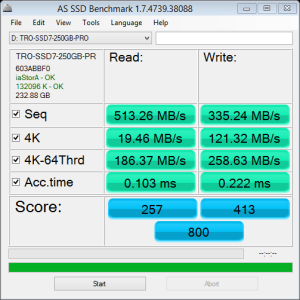The toughest benchmark available for solid state drives is AS SSD as it relies solely on incompressible data samples when testing performance. For the most part, AS SSD tests can be considered the ‘worst case scenario’ in obtaining data transfer speeds and many enthusiasts like AS SSD for their needs. Transfer speeds are displayed on the left with IOPS results on the right.
250GB
The overall score for AS SSD is 800 points, which is actually very good for a SandForce SSD of this capacity. The sequential read and writes reached 513MB/s and 335MB/s respectively. 4K read is just about were most SandForce SSD achieve as well, 19MB/s. 4K write reached a respectable 121MB/s as well. The access times are a bit high relative to newer SSDs with the read at 0.13ms and write at 0.222ms.
Along with AS SSD there is a Copy Benchmark that shows us the transfer speeds for different file types. The highest that it reached was 396.48MB/s for the ISO test and the lowest it reached was 254MB/s for the Game test.
500GB
Again, we see similar results from the 500GB in AS SSD as we did in Crystal Disk Mark. Its scores a total of 593 points, a little over 200 less than the 250GB. Write speeds dropped a considerable amount when compared to the 250GB capacity. The Access times are similar, however, at 0.126ms for the read and 0.216ms for the write.
For the Copy Benchmark we have the same result as the 250GB with the ISO file type being the fastest at 337MB/s and Game file type being the slowest at 266MB/s.
1TB
Last but not least we have the 1TB capacity and it shows some strong results. It scored 969 points, much higher than the lower capacity models. It also has much lower Access times at .040 for the read and .041 for the write as it is a newer controller.
Like the other capacities the ISO test proves to be the fastest at 409MB/s. However, unlike the other capacities the Program file type is the slowest for the 1TB at 297MB/s.
ANVIL STORAGE UTILITIES PROFESSIONAL
Anvil’s Storage Utilities (ASU) are the most complete test bed available for the solid state drive today. The benchmark displays test results for, not only throughput but also, IOPS and Disk Access Times. Not only does it have a preset SSD benchmark, but also, it has included such things as endurance testing and threaded I/O read, write and mixed tests, all of which are very simple to understand and use in our benchmark testing.
250GB
500GB
1TB
We see comparative results to the other benchmarks with Anvil’s Storage Utilities. The 250GB capacity reached a score of 4,328, the 500GB reached a score of 2,651, and the 1TB reached a score of 4,172. This shows that like that of previous benchmarks the 500GB capacity performs the least out of the three. However, for this benchmark the 500GB has the highest sequential read speed at 524.32MB/s. Also, the 1TB had the highest Sequential write at 431.16MB/s. Even though the individual values differed, the overall score between the 1TB and 250GB was relatively close.
Iometer is an I/O subsystem measurement and characterization tool for single and clustered systems. It was originally developed by the Intel Corporation however, they discontinued work on the program. In 2003 it was re-launched by an international group of individuals who are now continuously improving, porting and extend the product that is now widely used within the industry. This is a very powerful benchmarking tool and we are just now starting to integrate it into our consumer reviews. At this point in time we are going to be running a 4KB random workload at QD32 for 30 seconds and show the average to measure performance.
 We had some variance among the three capacities through our different benchmarks, so hopefully this one will prove to show some common results. As we can see the tests from the benchmark validate what we have been seeing from the previous ones. That is that the 500GB has the lowest performance out of these capacities and that the write for the 1TB is substantially higher than the other two. One thing that is different though is the 4K QD32 read for the 1TB is greater than the other capacities as well.
We had some variance among the three capacities through our different benchmarks, so hopefully this one will prove to show some common results. As we can see the tests from the benchmark validate what we have been seeing from the previous ones. That is that the 500GB has the lowest performance out of these capacities and that the write for the 1TB is substantially higher than the other two. One thing that is different though is the 4K QD32 read for the 1TB is greater than the other capacities as well.
 The SSD Review The Worlds Dedicated SSD Education and Review Resource |
The SSD Review The Worlds Dedicated SSD Education and Review Resource | 

Good review. I have been waiting for a new review on a sandforce drive with synchronous nand. It seems a lot of reviews of sandforce drives are with asynchronous nand, I don’t know why. You hear a lot about Samsung, crucial, and all the 100 million different controllers. But not much about sandforce/Seagate I guess because it is considered old, but it works and real
life and consistency seem to be just as fast as the new controllers all without a dram buffer. I can’t wait for Seagate and micron to pair the new sandforce controller with some premium micron nand then we will have a real ssd!